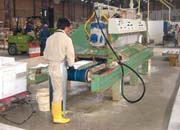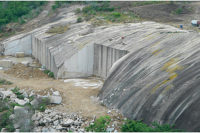
Located in Bogota, Colombia, Autentico S.A. started as a division within Granitos y Marmoles S.A., one of the leading companies in Latin America in the field of quarrying, fabrication and commercialization of natural stone, with over 48 years of experience. However, in 1992 Autentico S.A. was spun off, and thus became an independent company that is still associated with the Granitos y Marmoles group. Since then, it has concentrated on the design, development and production to rustic finishes, tumbled marble, mosaics and water basins in marble and other stones to satisfy a market that is more demanding every day. In addition to the company's coverage of the Colombian market through a complete distribution network in all of the main cities, Autentico is currently exporting its product line to several other countries, including the U.S., Venezuela, Ecuador, Chile, Panama, Costa Rica and most of the Caribbean Islands. Approximately 70% of the firm's sales are comprised of exports outside of Colombia.

Factory expansion
In November 2004, Autentico completed a significant expansion in which the entire factory was essentially moved to a new location. This new facility is approximately four times larger than the old factory, which has allowed the company to accommodate more machinery and materials. According to Autentico, this expansion was necessary due to growth and customer demand, which has been particularly strong over the last three years.
Equipment includes a range of saws and polishers, and one of the latest investments was a horizontal splitting machine from Tecnema of Italy. This machine allows the company to split stone horizontally into two pieces of various thicknesses. It is particularly valuable during the production of tumbled tile, as a single piece of stone can be tumbled and then split to create two finished pieces -- effectively doubling the production rate. Moreover, by placing thicker pieces of stone in the tumbler, the pieces are more durable, and the percentage of pieces broken during tumbling decreases dramatically. The company also added multi-disc cutting machines from Tecnema for cutting the smaller mosaic pieces.
The fabrication process
“In order to give a detailed explanation of the production process, I must first start by dividing the products that we make into three groups because their production processes are totally different,†explained Felipe Lesocki of Autentico. “The first group would be the marble tiles; the second one is mosaics and the third would be water basins (stone sinks).â€Tile production varies depending on the surface finish. “We divide the ones that are tumbled from the ones that have a different finish such as brushed -- which we call 'Antik' -- acid-washed, pillow edge, etc.,†Lesocki said. “Most of our tumbled marble is mounted on sheets and is produced in a thickness of 8 mm. This is required by a lot of our customers that use our products in combination with ceramic tile, which has the same thickness. When it is 6 x 6 inches or larger, it is not mounted on mesh, and the thickness in the larger formats goes up to 1 cm.â€
Autentico considers material selection to be a vital part of the production process. “Our tumbled [production] starts with the buying of the materials,†he said. “About half of our raw material is from Colombia, and the rest we import from different countries like Italy, Spain, Guatemala, Egypt, etc. The way we buy our material varies from case to case and so does the initial part of the production process. We try to get the best deal possible when buying our material, and for this reason we have to adapt how we buy it a little bit. In some cases, we buy blocks, and for our smaller formats, we can buy smaller or irregular blocks. This is how we purchase all of our Colombian materials. The next step is to cut them in 2-cm-thick strips, usually 12 or 16 inches wide. That is how we like to store most of the material inside the factory. In other cases, we buy materials already cut into 2-cm strips from factories abroad, because we find it is economically more convenient for us to do it this way.â€
Before tumbling, the materials are cut into their final dimensions, but with a thickness of 2 cm that will later be reduced when the stone is split horizontally. “The time that they have to be tumbled depends on the hardness of the material,†Lesocki said. “Some colors such as green from Guatemala can take four times as long to tumble than for example the Colombian Gold travertine.†After the stone has reached the desired finish in the tumbling machine, the tumbled pieces are then split to result in two pieces with an 8-mm thickness, with one side flat and the other tumbled. Then certain materials are acid washed, rinsed with water and dried, depending on the color. “This acid wash is quite diluted, and it does two things. It enhances the color and it cleans the material very well from the fabrication process,†he said, adding that the material is then mesh mounted using special “molds†that we have developed locally. “The designs are done by our own staff in AutoCAD, and then they are cut with a computer-controlled laser out of a special resin material. This is done by outsourcing with a local company that has this laser machine. The mesh is imported from Italy, and after it is glued to the marble, the sheets are passed though an oven so that the glue is completely dry and the sheets do not end up glued to each other inside the boxes.â€
When creating larger-format tumbled tiles, such as 12- x 12-inch pieces, the process starts with material in a 2.8-cm thickness, which ultimately results in finished tiles with a thickness of 1 cm each. For tiles with a brushed finish, the material starts with a 1-cm thickness, because it is not split during the process.
For mosaics, the company starts with 1-cm-thick tiles, and each piece is shaped by hand on a template done by computer, thus achieving a great level of detail. “We use this technique for very intricate designs and also for logos and other custom work,†Lesocki said.
For water basins or sinks, Autentico buys the material in standard blocks, which are then cut into smaller “mini†blocks. These smaller blocks are carved into solid sinks. After this, they are either polished or acid washed, depending on the customer's desired finish, and at the end, a sealer is applied before the product leaves the factory.
The company currently has 74 employees, including the factory workers and office personnel. According to Autentico, emphasis at the factory is on quality over quantity, which the company feels gives it an edge over some of the newer tumbled marble and mosaic producers that have entered the field over the past
few years.
In the U.S., Autentico's distribution structure mainly consists of wholesalers. Sales in the U.S. are handled by Stone Suppliers, LLC, of Westwood, MA, which is the commercial office of the Granitos y Marmoles group in America. “Nevertheless, we also handle a few of our clients directly, of which the most important would be Marble & Granite Inc., which represents our factory in the whole New England area,†explained Lesocki. “For Puerto Rico and the other countries in Latin America, we have our own group of representatives which travel periodically to visit our clients directly -- mainly wholesalers. We also exhibit our materials regularly at Coverings and other shows regularly in the Stone Suppliers booth.â€
In addition to standard production, the company also fabricates stone for major commercial projects. “Although most of our product is sold through wholesalers, for some large projects, we also have to deal directly with the contractors on the project,†Lesocki explained. “An example of this was the recently completed Four Seasons Hotel in Guanacaste, Costa Rica, for which our factory, Autentico S.A., supplied most of the stone used in the project. The principal stone used in this project was a Colombian limestone called Royal Veta, which comes from a quarry owned and operated by the Granitos y Marmoles group. It was installed at the pool in 4- x 4-inch tumbled tiles, and in the halls of the hotel in 12- x 12-inch tumbled tiles. It was also used for the interior of the bungalows in other formats and finishes.â€
In addition to Royal Veta, a variety of other stones were used at the Four Seasons in Costa Rica, including 4-x 4-inch tumbled tiles of Verde Guatemala as well as other colors and formats of mosaics. “The installation of the stone for this project was handled by Granitos y Marmoles, with most of the personnel involved being flown in directly from Colombia,†Lesocki said. “We have also done several other direct projects like these hotels in Panama and Chile.â€
